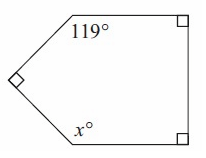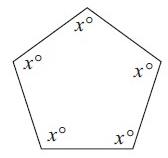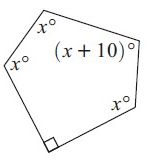PROBLEMS ON INTERIOR ANGLES OF A POLYGON
A polygon is a closed plane figure which has straight lines for sides.
The sum of interior angles of n sided polygon is
s = (n - 2) x 180°
|
Number of sides 3 4 5 6 7 8 9 10 |
Name of the polygon Triangle Quadrilateral Pentagon Hexagon Heptagon Octagon Nonagon Decagon |
Problem 1 :
Solve for x.

Solution:
Number of sides of the polygon given above = 5
Sum of interior angles of given polygon = (n - 2) × 180°
= (5 - 2) × 180°
= 3 × 180°
= 540°
119° + 90° + 90° + 90° + x° = 540°
389° + x° = 540°
x° = 540° - 389°
x° = 151°
Problem 2 :
Solve for x.

Solution :
Number of sides of the polygon given above = 5
Sum of interior angles of given polygon = (n - 2) × 180°
= (5 - 2) × 180°
= 3 × 180°
= 540°
x° + x° + x° + x° + x° = 540°
5x° = 540°
x° = 540°/5
x° = 108°
Problem 3 :
Solve for x.

Solution :
Number of sides of the polygon given above = 5
Sum of interior angles of given polygon = (n - 2) × 180°
= (5 - 2) × 180°
= 3 × 180°
= 540°
90° + (x + 10)° + x° + x° + x° = 540°
100° + 4x° = 540°
4x° = 540° - 100°
4x° = 440°
x° = 440/4
x° = 110°
Problem 4 :
The sum of the angles of a polygon is 1980°. How many angles has the polygon?
Solution :
Sum of interior angles of a polygon = 1980°
(n - 2) × 180° = 1980°
n - 2 = 1980/180
n - 2 = 11
n = 11 + 2
n = 13
Hence, the polygon has 13 sides.
Problem 5 :
Juan claims to have found a polygon which has angles with a sum of 2500°. Comment on Juan’s finding.
Solution :
Sum of interior angles of a polygon = 2500°
(n - 2) × 180° = 2500°
n - 2 = 2500/180
n - 2 = 13.8
n = 13.8 + 2
n = 15.8
Since the number of sides would not be decimal, there is no such polygon.
Recent Articles
-
Finding Range of Values Inequality Problems
May 21, 24 08:51 PM
Finding Range of Values Inequality Problems -
Solving Two Step Inequality Word Problems
May 21, 24 08:51 AM
Solving Two Step Inequality Word Problems -
Exponential Function Context and Data Modeling
May 20, 24 10:45 PM
Exponential Function Context and Data Modeling